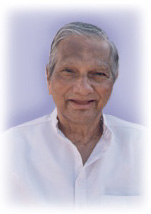Swami Madhavnath
 Divinity manifests itself through everybody and everything. However, we find its fullest manifestation in saints because they make their body, mind and intellect so pure that they become vehicles of the Divine Will. Swami Madhavnath is one such incarnation of Divinity.
Divinity manifests itself through everybody and everything. However, we find its fullest manifestation in saints because they make their body, mind and intellect so pure that they become vehicles of the Divine Will. Swami Madhavnath is one such incarnation of Divinity.
Swami Madhavnath (Shri Madhav Vishnu Wakade) was born in Kokban, Maharashtra, on 1 October 1917. At the age of ten he began to study the Bhagavad Gita and soon moulded his life upon its principles. After the premature death of his father, he decided to leave his ancestral home in his native village and to come to the city of Pune. He was only seventeen then, and his migrating to a new place with almost no money and a mother and younger sister to support, showed remarkable courage and detachment. By dint of hard work he set up a cloth store and in 1939, he married his childhood friend, Sarojini. She later came to be known as Saralamatoshri or Mother Saralatai. While leading the life of an ideal householder, he practised meditation and namasmaran(recalling the name of God). He made a deep study of the Jnaneshvari and Dasabodh and attained first-hand experience of their spiritual essence.
In 1958, Swamiji began to give discourses on the Jnaneshvari in Pune. It was in 1968, that he met his sadguru (spiritual guide), Swami Swarupananda of Pawas. In 1973, Swami Swarupananda entrusted him with the responsibility of carrying forward the spiritual tradition of the Natha Sampradaya. Swamiji then strove for the upliftment of spiritual aspirants and initiated thousands of disciples. He conducted spiritual discourses and satsangas in Pune and also all over Maharashtra. Several books, audio and video cassettes of his teachings are available.
Swamiji’s was a fascinating personality -- a multi-dimensional personality in every sense of the word. It could be so because he had reached the very pinnacle of spiritual perfection. Swamiji excelled at the tennis court, was a successful businessman, an ideal householder and yet led a life with single-pointed attention towards the spiritual goal of attaining Self-realization. In the latter part of his life, Swamiji stood as one of the greatest champions of the spiritual message of the ancient Rishis.
Swamiji’s ideal life and lucid teachings removed several misconceptions regarding spirituality. For example, people are afraid that worldly life might have to be renounced or will at least be neglected if one turns towards spirituality. Swamiji’s own life showed a perfect and proportionate blending of the worldly duties of a householder with the commitments of a spiritual aspirant. Several people also have misconceptions about spirituality because it often happens that the faith of the common man is exploited by some people who pretend to be saints and even cheat those who come to them. They offer to cure illness or solve difficulties in worldly life and do not really give spiritual guidance. Apart from such extreme cases of hypocrisy, even the the behaviour of those who are honest preachers does not always reflect the ideals they preach. Swamiji practised what he preached. His life showed that paraphernalia like long beards, beads and saffron clothing, meaningless rituals and severe penance have nothing to do with Self-realization.
Seeing that people are simply not aware of spirituality and are hence deprived of the wealth of spiritual truth in the scriptures, Swamiji logically convinced people that spirituality is absolutely necessary for happiness in one’s daily life. These teachings inspired thousands of people and especially the youth towards whom Swamiji showed intense affection. Swamiji gave them personal attention, emancipated them from all unhealthy habits and taught them to lead a more dynamic and at the same time a more mentally and spiritually calm life. He felt that since spirituality is a subtle science and it takes long to mould and transform an individual, he should concentrate upon the total reform of one set of individuals by repeatedly teaching them. He believed that these individuals would attain Self-realization and in turn, teach others to do so. There would be a spiritual renaissance which would gradually bring about social reform. Had Swamiji travelled widely to spread his message he would have won much greater fame than he did, but he sacrificed himself wholly for what he recognized as his mission.
Swamiji’s love knew no bounds. Once a young man in his early twenties who was suffering from insomnia came to him. Sleepless nights had made him so restless that he was almost insane. Although a stranger, Swamiji called him to his house and gently patted him to sleep himself and it was only on the third night that the young man slept soundly. He began to lead a normal life thereafter.
It was not only Swamiji’s selflessness and love that drew people to him. His cheer, vigour and scintillating wit also attracted them. Humour, for Swamiji was the very salt of existence. Even after his right side was paralysed in 1991, just before his seventy-fourth birthday, Swamiji maintained his jovial attitude. So great was his commitment to his mission that he continued to initiate disciples and deliver discourses despite his ailment.
Swamiji’s magnetic personality, powerful oratory, love and compassion continued to attract several people until he laid aside his mortal body on 30 July 1996.
Today Swamiji’s successors Swami Madhavananda and Swami Makarandanath are striving to realize his ideals. His wife Saralatai, who with her virtues like love, tenderness and forbearance, supported him untiringly in his mission, continues to be a mother to all those who come to the Centre.
